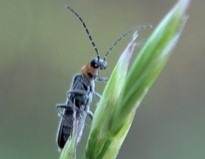Soldier Beetles: Difference between revisions
Jump to navigation
Jump to search
Tag: Manual revert |
|||
| Line 2: | Line 2: | ||
Soldier beetles (Cantharidae) are the second largest group in the beetle (Coleoptera) superfamily Elateroidea, containing approximatley 5,500 species <ref name= "motyka">Motyka, M., Kusy, D., Biffi, G., Geiser, M., Kazantsev, S.V., Bilkova, R., Jahodarova, E., Vogler, A.P., Bocak, L.. (2023). Untangling the evolution of soldier beetles ([[Coleoptera]]: Cantharidae) and the evaluation of the morphological phylogenetic signal in a soft-bodied elateroid lineage. Cladistics. 39: 548-570. https://doi.org/10.1111/cla.12555.</ref>. Soldier beetle larvae tend to be darkly colored and look almost reptilian. Adult soldier beetles grow to about half of an inch long and are yellow to tan in color. Some abdominal segments are exposed, as their wings do not entirely cover their body. These [[insects]] are beneficial, as they mainly feed on nectar and act as a pollinator species <ref name= "hahn">Hahn, Jeffrey. (2023). Soldier beetles. University of Minnesota Extension.</ref>. | Soldier beetles (Cantharidae) are the second largest group in the beetle (Coleoptera) superfamily Elateroidea, containing approximatley 5,500 species <ref name= "motyka">Motyka, M., Kusy, D., Biffi, G., Geiser, M., Kazantsev, S.V., Bilkova, R., Jahodarova, E., Vogler, A.P., Bocak, L.. (2023). Untangling the evolution of soldier beetles ([[Coleoptera]]: Cantharidae) and the evaluation of the morphological phylogenetic signal in a soft-bodied elateroid lineage. Cladistics. 39: 548-570. https://doi.org/10.1111/cla.12555.</ref>. Soldier beetle larvae tend to be darkly colored and look almost reptilian. Adult soldier beetles grow to about half of an inch long and are yellow to tan in color. Some abdominal segments are exposed, as their wings do not entirely cover their body. These [[insects]] are beneficial, as they mainly feed on nectar and act as a pollinator species <ref name= "hahn">Hahn, Jeffrey. (2023). Soldier beetles. University of Minnesota Extension.</ref>. | ||
[[File:soldierbeetle.jpeg|501px|thumb|center|Soldier Beetle on a | [[File:soldierbeetle.jpeg|501px|thumb|center|Soldier Beetle on a Plant in South Carolina, USA (Photographed by bec325, 2025). <ref name= "pics">iNaturalist. https://www.inaturalist.org/.</ref>]] | ||
== Taxonomy == | == Taxonomy == | ||
Revision as of 11:09, 10 April 2025
Description & Overview
Soldier beetles (Cantharidae) are the second largest group in the beetle (Coleoptera) superfamily Elateroidea, containing approximatley 5,500 species [1]. Soldier beetle larvae tend to be darkly colored and look almost reptilian. Adult soldier beetles grow to about half of an inch long and are yellow to tan in color. Some abdominal segments are exposed, as their wings do not entirely cover their body. These insects are beneficial, as they mainly feed on nectar and act as a pollinator species [2].

Taxonomy
Ecology & Evolution
References
- ↑ 1.0 1.1 Motyka, M., Kusy, D., Biffi, G., Geiser, M., Kazantsev, S.V., Bilkova, R., Jahodarova, E., Vogler, A.P., Bocak, L.. (2023). Untangling the evolution of soldier beetles (Coleoptera: Cantharidae) and the evaluation of the morphological phylogenetic signal in a soft-bodied elateroid lineage. Cladistics. 39: 548-570. https://doi.org/10.1111/cla.12555.
- ↑ 2.0 2.1 Hahn, Jeffrey. (2023). Soldier beetles. University of Minnesota Extension.
- ↑ 3.0 3.1 iNaturalist. https://www.inaturalist.org/.